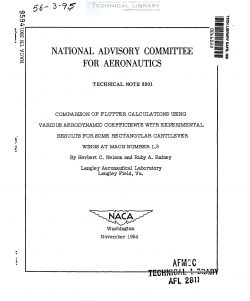naca-tn-3301
- Version
- 44 Downloads
- 695.00 KB File Size
- 1 File Count
- January 23, 2017 Create Date
- January 23, 2017 Last Updated
National Advisory Committee for Aeronautics, Technical Notes - Comparison of Flutter Calculations Using Various Aerodynamic Coefficients with Experimental Results for Some Rectangular Cantilever Wings at Mach Number 1.3

A general Rayleigh analysis is used as a basis for developing four
methods of flutter analysis that are applied to twelve low—aspect-ratio
wings. These wings were previously tested at a Mach number of 1.3 by
progressively varying certain wing parameters until flutter occurred.
They were rectangular in plan form and had aspect ratios between 3.00
and h.55. The four methods of flutter analysis used are: section coef-
ficients for harmonically pitching and translating rectangular wings in
a Rayleigh type of analysis, two-dimensional coefficients in a Rayleigh
type of analysis, total coefficients for harmonically pitching and trans-
lating rectangular wings in a representative—section analysis, and two-
dimensional coefficients in a representative-section analysis. Each of
the four methods involved two degrees of freedOm, namely, first bending
and first torsion of a cantilever wing.
The analytical results are compared with the previously obtained
experimental values. The comparison indicates that the use of section
aerodynamic coefficients derived on the basis of three-dimensional flow
leads to a significant improvement in the correlation of theory and
experiment.
The problem of theoretically determining the flutter characteristics
of unswept wings of low aspect ratio in supersonic flow has become of
increased interest. Mbst of the previous analytical work on this problem
has been based on air-force and moment coefficients for two-dimensional
supersonic flow, such as those tabulated in reference 1. For example,
reference 2 presents the results Obtained at a Mach number of 1.5, by
using two-dimensional coefficients in a representative-section type of
flutter analysis, for twelve unswept wings with aspect ratios ranging
from 5.00 to h.55. As explained in reference 2, these wings were also
tested at a Mach number of 1.3 by progressively shifting their centers
of gravity and elastic axes and modifying their bending and torsional
frequencies until flutter occurred. A comparison of the calculated and
experimental results showed that in the majority of cases the calculated
flutter speeds were considerably below the experimental flutter speed.
This discrepancy suggests in part that, at least in the low supersonic
speed range, two-dimensional coefficients are inadequate and more real-
istic aerodynamic coefficients should be used in the flutter analysis
of unswept low-aspect-ratio wings.
| File | Action |
|---|---|
| naca-tn-3301 Comparison of Flutter Calculations Using Various Aerodynamic Coefficients with Experimental Results for.pdf | Download |

Comment On This Post